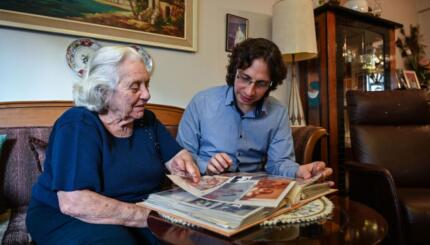Beginning in the late 18th century, newly emancipated Jews in Europe embraced the Hebrew language as a tool for creating a new Jewish culture. However, until then, Hebrew was only used during prayer and religious study. Turning Hebrew into a literary language was a daunting task, which only a very select group of individuals could accomplish. Reprinted with permission from Hebrew and Modernity, published by Indiana University Press.
Who were the people who created this new literature? How did they get a knowledge of the language sufficient to such an undertaking? What were the material conditions in which a literature so anomalous sustained itself? The makers of modern Hebrew literature were, almost without exception, male and the products of an Orthodox upbringing. (In the earlier Haskalah–Enlightenment–a good many still preserved some form of enlightened orthodoxy; later on, the overwhelming majority of the writers were men who had broken decisively with the world of Jewish observance of their childhood.) The gender and the religious background of the writers were determined by the peculiar educational system developed by European Jewry before its entry into modernity; the system, in turn, was associated with the equally peculiar social structure of East European Jewry; and both require a little explanation.
One of the oddest–and most crucial–cultural circumstances of traditional East European Jewry was that its masses, by and large, lived under the conditions of an impoverished peasantry while enjoying almost universal literacy. They were not, of course, a peasantry in being able to work the land: For the most part, they eked out their living as middlemen, petty tradesmen (and often tradeswomen), peddlers, estate managers, and tax collectors, publicans, artisans. But a typical shtetl house, as one can see from photographs and films taken in Poland as late as the 1920s, would have looked not very different from the makeshift quarters of a black sharecropper in the American South: a one‑room shack with dirt floor, without plumbing, crowded by a family with many children, perhaps even with the addition of an old grandparent. One readily understands why Mendele Mokher Seforim, the greatest fictional chronicler of these Jews in the Russian Pale of Settlement, should call one of his typical towns Kabtsiel, or Beggarsville.
I have said that these near paupers and actual paupers were mostly literate, but it was a two‑track literacy reflecting a two‑track educational system. The girls were instructed at home to read the vernacular Yiddish, and since the Hebrew prayer book was written in the same Hebrew alphabet as Yiddish, they could also, as grown women, in order to fulfill the impulse of piety, "read" the prayers as well, without however understanding more than isolated words and phrases. The boys began heder, or elementary school, before the age of five, and were immersed in a curriculum that was entirely limited to the close study of Hebrew and, later, Aramaic texts.
With your help, My Jewish Learning can provide endless opportunities for learning, connection and discovery.
The young boys were led through the Pentateuch verse by verse, each Hebrew phrase being given its Yiddish equivalent in a kind of oral interlinear translation. Other books of the Bible might be accorded some attention when preparation was being made for their public reading at the appointed festivals (Song of Songs at Passover, Ruth at Shavuot, and so forth), and biblical texts fixed in the daily prayers, including dozens of Psalms, would be gotten by heart through sheer force of repeated recitation. But there would be no formal teaching of principles of grammar, no vocabulary lists, no exercises in composition. Indeed, the teenage students who happened to get hold of a Hebrew grammar treated it pretty much as underground literature, knowing that their rabbinical mentors would regard as an act of subversion any attempt to study the Holy Tongue systematically, with "secular" tools, as though it were a language just like any other.
By the time a boy reached the age of legal induction into Jewish manhood at 13, if he was an alert pupil and if his schoolmaster had not been totally incompetent (incompetence being more or less endemic to the system), he could read biblical Hebrew with an approximation of understanding, would have had some introduction to the primary rabbinic text, the Mishnah, and to the main medieval Hebrew commentaries on the Pentateuch, and would have a reasonably adequate understanding of the Hebrew of the prayer book. In fact, the extreme unevenness of instruction meant that most products of the heder were functionally illiterate in Hebrew, retaining only the most rudimentary vocabulary and a fuzzy or mangled understanding of particular texts.
After the age of 13, a large part of the student body dropped out, some after a year or more of additional instruction, to become apprentices, to assist in the family business, or otherwise to enter the workforce, and sometimes to be married off by their parents by the time they were 15. The more gifted went on to the yeshiva, or talmudic academy, often having to move to a larger town where there was such an institution. The subject of study at the yeshiva was exclusively the Babylonian Talmud, a vast corpus of texts composed in a mélange of Hebrew and its cognate language, Aramaic; as always, the language of discussion among students, and between students and teacher, was Yiddish.
The school days were long, the demands relentless; students worked over the difficult texts and their commentaries in pairs, and then listened to a general lesson from the yeshiva instructor. The complementary intellectual qualities they were encouraged to develop were a prodigious retention by heart of the talmudic texts and their biblical precedents (beqi’ut) and an analytic sharpness accompanied by ingenuity (harifut). Most boys left the yeshiva by their late teens, some, having received ordination, to take up rabbinical posts, many, having entered into an arranged marriage, to enjoy a period of private learning subsidized by a prosperous father‑in‑law who was willing to pay this price in order to have his daughter married to a man of learning.
From the account I have offered, it must surely seem a mystery that anyone could have emerged from this educational system with a sufficient grasp of the Hebrew language to write an essay, a travel book, a sonnet, or, especially, a novel. The yeshiva population was the intellectual elite of Central and East European pre-modern Jewry. The Hebrew writers produced by the yeshivas were an elite within an elite. In part, I mean simply that they were the equivalent of the A+ students in the system, and certainly the evidence many of them offer of retentive memory and (to a lesser degree) of dialectic subtlety, of beqi’ut and harifut, is formidable. But I am also referring to a rather special mental aptitude which was not necessarily given special value within the system but which would have abundant uses outside the system, something that the Germans call Sprachgefuhl, an innate sense, like perfect pitch in music, for how language should properly sound, joined with a relish for the sonorities and the semantic colorations of Hebrew words in their classical idiomatic combinations.
Minds of this almost preternaturally prehensile cast would catch onto every nuanced collocation, every linguistic particle, in a traditional Hebrew text, both those that were part of the curriculum and those that were not. And as a new Hebrew culture began to shimmer before such unusual students as a radical alternative of Jewish identity to that of the Orthodox system, they would, even in the yeshiva milieu, do a good deal of reaching, often surreptitiously, beyond the curriculum to the parts of the Bible not officially studied, to the medieval philosophers and poets, to those newfangled Hebrew grammars, and, worst of all, to the godless journals, the poetry and fiction, of the new Hebrew literature.
shtetl
Pronounced: shTETTull, Origin: Yiddish, a small town or village with a large Jewish population existing in Eastern or Central Europe in the 19th and early-to-mid 20th century.
yeshiva
Pronounced: yuh-SHEE-vuh or yeh-shee-VAH, Origin: Hebrew, a traditional religious school, where students mainly study Jewish texts.


